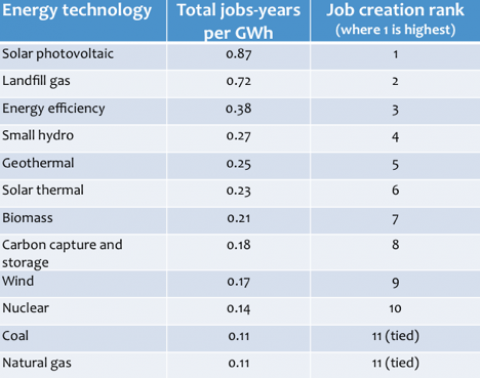Ontarians head to the polls on Thursday to elect the next provincial government, at the close of an election campaign where green energy has emerged as a hot-button issue. As the rhetoric has escalated on all sides of the debate, Ontario voters have also had to wade through a great deal of misinformation about their energy options.
Since the choices Ontarians make on Thursday could shape Ontario's electricity system for decades to come, we set out to clarify some of the misconceptions about Ontario energy choices, so that when voters head to the polls, they are armed with the facts.
FACT: The Green Energy Act will not dramatically increase the price of electricity.
Even if Ontario stopped all new investment in renewable power today, electricity prices would continue to rise. This is due to the inevitable expense of upgrading our ageing electricity grid and building new power plants as old ones retire.
 Critics of green energy are falsely comparing the cost of renewable energy projects today with the price of electricity from facilities built thirty years ago. Any comparison should be against the cost of building and operating any new power plant.
Critics of green energy are falsely comparing the cost of renewable energy projects today with the price of electricity from facilities built thirty years ago. Any comparison should be against the cost of building and operating any new power plant.
The Pembina Institute recently modeled these complex interactions for Ontario's electricity system. Our report on that study, Behind the Switch, found that cancelling the Green Energy Act would likely result in a slightly slower price increase in the short term — saving the average household about the cost of a cup of coffee and a muffin per month. In the longer term, however, the Green Energy Act would result in cost savings for consumers, since the cost of renewables will continue to decrease every year, while the price of natural gas is forecast to continue increasing over the next 20 years.
FACT: Green energy has existed for decades without harmful side effects
In June, I toured parts of Ontario with a German farmer, Hans Feddersen, who has been living with more than 60 turbines in the fields of his local community for 20 years. After a few media interviews, the farmer expressed confusion and frustration because the questions were so focused on health issues — rather than the tremendous benefits of renewable energy.
According to Feddersen, Germany addressed those issues years ago; Feddersen said health concerns associated with wind energy "isn't a topic anymore" in his country, which is leading the world in wind power production.
The first policies to form the German equivalent of Ontario's Green Energy Act were instituted 20 years ago in Germany. Those policies have been updated and improved over time by successive governments on both ends of the German political spectrum. Similarly, Ontario's Green Energy Act has room for improvement, and we can learn from Germany, where strong community involvement in the program has led to both profits for rural residence along with strong support.
While we recognize that renewable energy technologies — ranging from hydro, to biomass, to wind turbines — do have local impacts that need to be minimized and addressed through effective, local public consultations, fossil fuels pose a more serious threat to human health and the environment.
FACT: Grandmothers do not have to do their laundry at 2 a.m. because of smart meters
Despite what some politicians are saying, smart power meters do not create an unfair burden by increasing electricity prices. Off-peak hours in Ontario begin at 7 p.m. on weekdays, while mid-peak pricing starts at 5 p.m. and any electricity used over the weekend gets charged at off-peak rates. It's good to consider how changes to Ontario's electricity pricing system will affect lower-income and fixed-income Ontarians, but there's little evidence that time-of-use pricing presents additional cost burden on those households.
A case study in Milton, Ontario, looked at the effect of moving to time-of-use pricing, from flat rates for electricity, based on data from1020 households. They found that for 98.2 per cent of customers, the move to time-of-use billing amounted to less than a five per cent change (either up or down) in their electricity expenses. On average, the switch to time-of-use billing resulted in a 0.233 per cent increase. In another study, a master's student at the University of Guelph looked more specifically at low- and fixed-income households. She found that they were slightly worse off with time-of-use rates in the summer and slightly better off with time-of-use rates in the winter. In both cases, the differences were reasonably small.
Eliminating the harmonized sales tax (HST) from electricity bills is not the solution to high electricity bills, because doing so would increase consumption at a time when we're facing a critical need to reduce and electricity demand overall. Implementing better energy conservation programs would reduce energy use while saving consumers money. In comparison, removing the HST from energy bills would increase consumption and cost us all more in the end because of the need for additional power sources and expensive infrastructure.
FACT: Green energy creates jobs for Ontarians
Because Ontario is still developing its clean energy economy, it is difficult to calculate exactly how many jobs have been created and will be created through the Green Energy Act. However, there is no question the legislation is creating jobs:
The Blue-Green Alliance has developed a map of existing and proposed jobs at the 40 new manufacturing facilities in Ontario that have been announced. This summer, ClearSky Advisors released studies estimating that by 2011, solar energy in Ontario generated two billion dollars of private sector investment and 8,200 jobs, and they estimate that solar PV energy itself is will create 70,000 jobs in Ontario by 2018.
A recent Pembina Institute analysis found that all renewable energy technology, including energy efficiency, currently generates three to 10 times the number of jobs per hour of energy generated than fossil fuels or nuclear (see table below).
TABLE: Job creation per hour of energy generation
The potential for green energy investment and manufacturing in Ontario is only growing, meaning that this is one sector that will continue to generate jobs and economic stimulus now and in the future. Cancelling our green energy program and killing these jobs would be harmful to Ontario's economy, which is faring well in tough times thanks in large part to the Green Energy Act.
FACT: Subsidies to renewable energy are no greater than those for fossil fuel and nuclear power
The criticism of the price Ontario currently pays for renewable energy ignores two important facts: renewable prices are still falling, while the costs of fossil fuels and nuclear are rising — and the government subsidizes fossil fuels and nuclear energy to a much greater extent than green energy.
The nuclear industry has been subsidized since day one. Nuclear has accumulated over $20 billion in subsidizes federally, including over $1.2 billion in the past five years — and it continues to collect federal subsidies now, even after being sold to SNC Lavelin.
Compare that to wind, solar and biomass industries that together have received about $1.7 billion from the federal government, which are being spread out from 2002 to 2021. In other words, 10 years from now, renewable energy will have received about 10 per cent of the subsidies nuclear has received — assuming no more nuclear subsidies are paid out in the next 10 years.
The California Energy Commission estimated new nuclear costs between 17-34 c/kWh in 2010. The low end of that estimate is still more expensive then Ontario's prices for wind power under the feed-in tariff, and the high end approaches the feed-in tariff price for large-scale solar power projects at current costs, which have been dropping rapidly (down 50 per cent) in past five years.
FACT: Feed-in tariffs are the most effective tools to develop renewable energy
Feed-in tariffs, or FITs, are the cornerstone policy of the Green Energy Act, which pays renewable energy producers to feed energy onto the electricity grid. Studies have found that feed-in mechanisms achieve larger deployment at lower costs than other policy mechanisms such as quotas, direct incentives or voluntary goals — making feed-in tariffs the most efficient and cost-effective policy to procure renewable energy.
Feed-in tariffs have also largely been credited for supporting green job creation in Europe. The FIT in Ontario is crucial to foster the urgently needed transition to clean energy, maintain jobs creation and ensure investment from domestic and global players. While the Green Energy Act could and should be improved now that it has been in operation for two years, it is still arguably the most progressive renewable energy policy in North America in the past 20 years.








